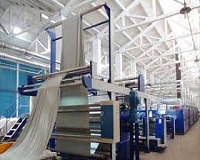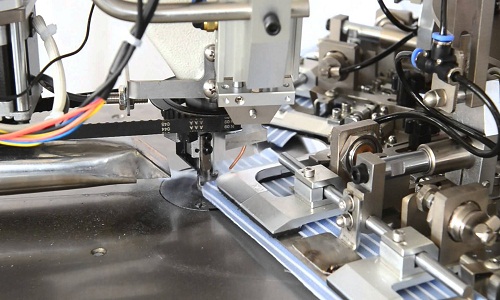FW
Hansae, a South Korean apparel manufacturer, recently stated that it will build another factory in Myanmar as it moves to protect worldwide keenness in the face of a strong local money and a rise in raw material prices.
Hansae, which makes clothes for international brands such as Nike and Gap, stated that at present it is looking for a factory site in the Southeast Asian country, where it already functions one production plant.
Hansae is a Seoul-based company mainly engaged in manufacturing of garments like shirts, knits, women's suits and casual apparel. It has production units in Guatemala, Indonesia and Vietnam, from where it exports to overseas buyers, such as Abercrombie & Fitch, American Eagle, Gap, Hollister, Sears, Kohl's, Nike, Old Navy, and others. It was founded in 1982, it has 17 corporations in six countries Vietnam, Nicaragua, Guatemala, Indonesia, Myanmar and Haiti.
The latest investment decision comes amid the strengthening of the local currency, which could undermine price competitiveness of South Korean goods in the global market. The Korean won averaged 1,067.76 won against the U.S. dollar in April, up from an average 1,071.89 won in March.
Imports of the products in April reached US$497.05 million, bringing the total import value in four months to US$1.74 billion, down 0.02 per cent against the corresponding period last year.
At present, the five major suppliers with a value of more than US$100 million each are China, the Republic of Korea, Taiwan, the US and Southeast Asian countries. China took the lead at more than US $ 645.95 million (down 4.3 per cent), accounting for 37.2 per cent of Vietnam’s total imports, trailed by the RoK (down 5.1 per cent to nearly US$226.16 million), Taiwan (down 11.2 per cent to US$148.11 million), the US (up 14 per cent to US$118.83 million) and Southeast Asian countries (up 14.2 per cent to US$113.55 million).
It’s noteworthy that imports of the materials from many markets particularly from Canada increased against the same period last year.
Meanwhile, imports from other markets suffered a sharp decline, including Argentina (down 51 per cent to US$7.68 million), New Zealand (down 50.3 per cent to US$4.23 million), France (down 41.6 per cent to US$1.3 million), Austria (down 32.8 per cent to US$0.44 million) and Germany (down 31.4 per cent to US$8.44 million).
Vietnam plans to increase its import-export revenue through the implementation of 10 free trade agreements (FTAs) which are being utilised effectively by enterprises.
One of these includes the VKFTA signed between Vietnam and the Republic of Korea (RoK) in 2015. This FTA helped Vietnam expand its textile and garment exports to the RoK which reached US$2.6 billion in 2016,while the export revenue was reported at US$2.9 billion in 2017, an increase of 11.8% compared to 2016.
The FTA between Vietnam and the Eurasian Economic Union which became effective in October 2016, also contributed to increasing Vietnam's textile and garment exports to Russia from US$84.8 million in 2015 to approximately US$172 million in 2017.
In particular, all FTA signatory markets have recorded higher rates of import and export growth compared to the time before the signing of FTAs.
Of those, Chile is among the markets posting the highest export growth rate with an annual growth rate of 46.68 per cent per year.
It is followed by India with an average annual growth rate of 31.58 per cent, the RoK with an annual growth rate of 29.8 per cent per year, and China with an average growth rate of 21.71 per cent per year.
Meccano, a New Zealand retailer is currently in deep financial crisis as it owns its creditors debts of $5.8 million .
The company is facing several difficulties, including costly leases, with only three months of profitable trading after De Vere Investments purchased and took over the business in February 2016.
The retailer will pay Westpac bank a chunk of the $588,000 it owes but $89,000 owed to workers and $90,000 Inland Revenue will likely not be paid.
The retailer also owes unsecured creditors $5.1m, $2.5m of that in trade creditor claims, $104,000 in employee entitlements and related-party payables of $2.6m. Unsecured creditors would only receive money if there are recoveries that we can make in the liquidation.
Jackson and Grant Graham were appointed liquidators to the retailers. Meccano ceased trading in February when it was placed into voluntary administration.
Meccano had 12 retail stores throughout New Zealand and an online store
Cotton T-shirts are gaining popularity amongst Indian customers. Around 87 per cent feel that cotton is the most comfortable apparel, compared to other man-made fibres.
According to the Cotton Incorporated Lifestyle Monitor Survey, around 85 per cent believe cotton to be most sustainable, trustworthy and soft, 83 per cent feel it is more authentic while 81 per cent term it as reliable material.
Consumers today also prefer t-shirts made of authentic natural fibers. In the survey research, about 59 per cent of respondents expressed about brands and retailers substituting man-made fibers for cotton in their t-shirts. Women are significantly more likely than men to be irritated by this.
Additionally, according to the data, around 65 per cent of the consumers are willing to pay a premium to keep their T-shirts cotton-rich. Additionally, more than 7 in 10 believe that better quality garments are made from natural fibers like cotton.
With the slogan ‘Colombia is the greatest saved secret in the Americas’, the participation in the occasion is organized by Professional Colombia, the Colombian authorities’ body that promotes non-mining exports, tourism and funding. “Colombian design mixes great creativity inspired by the country’s biodiversity with the utmost respect for natural resources and the support for vulnerable communities.
The Miami Fashion Week is a superb alternative for positioning Colombia as the style supplier for the United States and Latin America. In 2017, Colombia exported $286 four million to this market leveraging the advantages of the FTA between each nations. Currently, Colombian clothes and manufacturing inputs attain greater than 100 locations round the globe.
Colombia has a 100-year-old custom and experience in style improvement. It is the third greatest world exporter of management clothes and the fifth textile and inputs exporter of South America. Fabric manufacturing with good applied sciences with added values as UV safety, pores and skin moisturizer and anti-humidity, are some of the examples of the nation’s portfolio. Besides, Colombian enterprises can adapt to consumer’s wants resembling minimal versatile manufacturing and aggressive supply schedules.
The United States threatened to impose tariffs on $50 billion of imports from China unless Beijing addressed the issue of theft of American intellectual property.
This declaration came after the two sides had agreed earlier this month to look at steps to narrow China's $375 billion trade surplus with America.
Fears of a trade war between the world's two biggest economies had receded after the administration of President Donald Trump had reached a deal that would put ZTE Corp back in business after banning China's second-biggest telecoms equipment maker from buying US technology parts.
Still hanging in the balance, however, is San Diego-based Qualcomm Inc's proposal to acquire NXP Semiconductors NV - a $44 billion deal that requires clearance from China's antitrust regulators.
The recent easing in tensions had fueled optimism that an agreement was imminent.
Bangladesh’s readymade garment sector is much safer than in 2013 when the Rana Plaza disaster occurred.
Dramatic improvements are taking place that are bringing the sector up to world-class standards. The country has made progress on workplace safety, especially with the support of buyer-led initiatives like Accord and Alliance.
However there is still work to be done on factory and building safety. Efforts to ensure remediated factories stay safe must be continued. Workers must be properly trained on safety practices.
Above all there is need for a quick resolution on Accord’s and Alliance’s extensions in Bangladesh. Delays in approving their extensions will send a negative signal to buyers and consumers that Bangladesh is not committed to workplace safety.
Resolving the long-standing labor rights concerns will help Bangladesh focus on preparing for its future as a middle income country and, eventually, a developed country.
Bangladesh is preparing to graduate from least developed country status in 2024.
Child labor is being weeded from hazardous jobs. Labor laws are being made worker-friendly. The country is now very proactive, candid and open in terms of having discussions over labor issues.
A training program has been launched for around 0.8 million readymade garment workers.
"A new 56-page report entitled ‘Sustainable Fashion Blueprint Report 2018’ reviews the state of the industry, analysing the sustainability initiatives currently being implemented, and offers a framework that fashion businesses can follow in their efforts to reduce their negative environmental and social impacts. The report authored by University of Cambridge MBA students Diane Albouy and Olabisi Adesida in partnership with ethical e-commerce marketplace Mamoq."
 A new 56-page report entitled ‘Sustainable Fashion Blueprint Report 2018’ reviews the state of the industry, analysing the sustainability initiatives currently being implemented, and offers a framework that fashion businesses can follow in their efforts to reduce their negative environmental and social impacts.
A new 56-page report entitled ‘Sustainable Fashion Blueprint Report 2018’ reviews the state of the industry, analysing the sustainability initiatives currently being implemented, and offers a framework that fashion businesses can follow in their efforts to reduce their negative environmental and social impacts.
The report authored by University of Cambridge MBA students Diane Albouy and Olabisi Adesida in partnership with ethical e-commerce marketplace Mamoq.
Data collected through a Mamoq consumer research survey, reveals some interesting insights into consumers’ knowledge of sustainable fashion.
As sustainable fashion is a still evolving concept, it cannot be defined easily. The concept broadly refers to the design, production, distribution, consumption and disposal of apparel in consideration with the health and longevity of the natural environment, animals and humans involved.
design, production, distribution, consumption and disposal of apparel in consideration with the health and longevity of the natural environment, animals and humans involved.
It aims to limit the socio-environmental cost of fashion, while maximising its lifetime value and positive impact
The fashion industry being one of the most polluting industries in the world, sustainability is gaining traction. Consumers, particularly millennial and Generation Zs, are becoming increasingly aware of the challenges of sustainability, leading to changes in shopping habits.
According to the Cotton Council International and Cotton Incorporated Global Environment Survey, sustainability is a high priority for consumers in countries such as, India (81 percent), Mexico (69 percent), Italy (62 percent), and China (60 percent) However, the increased awareness of sustainability in the fashion world has yet to lead to a universal definition of sustainable fashion .
The need to adopt sustainable fashion
Sustainable fashion initiatives can help consumers, with lower disposable income to easily access ethically-made apparel from a transparent production line. These initiatives can also enlighten consumers on the importance of sustainability, and show that sustainable fashion can be of good quality, affordable and diverse.
They help existing businesses manage costs, minimise reputational risk, diversify revenue streams, and address consumer expectations. These also help fashion companies to redefine their long-term goals and strategies. Since consumers are exposed to more fashion choices than ever before, they are more empowered to demand more transparency, accountability, and quality.
Ways to adopt sustainable fashion
While choosing to implement the principles of sustainability to fashion, incumbents may face three types of challenges. Firstly, he needs to dedicate a budget, headcount and time across the organisation for a long-term implementation of sustainable initiatives. Secondly, the management needs to be aware that implementing these principles may directly impact margins and lastly these initiatives are likely to challenge the corporate governance structure of the company as agency issues arise.
To overcome these challenges the incumbent can adopt the following measures. • Use of bio-degradable materials: Brands need to make atleast 95 per cent of their entire collection from bio-degradable materials such as cotton, linen, or wool. • Reduction carbon footprint: Brands need to actively limit reduce their carbon foot print, thus limiting their negative impact on the environment. • Use of recycled materials: Brands should use recycled materials to limit the environmental impact of production and reduce landfill waste • Third Party Certified: Brands have been thoroughly vetted, and officially verified by a third party organisation (e.g., Fairtrade and Oeko-Tex) • Animal-free production: Brands should be committed to animal-free production. • Charitable activities: Brands should demonstrate an ongoing commitment to charitable activity. This includes the “buy to give” model, as well as financial donation • Transparency: Brands operate on a fully transparent and traceable supply chain. This promotes accountability of production and higher ethical standards. • Organic: Brands should use organic materials to limit the negative impact of farming on our ecosystems and personal health
"Automation has been making inroads in the textile industry rapidly owing to increasing competition, rising labour costs and lack of skilled workforce. While the industry has started taking steps, it has yet to catch up with the global counterparts. Deploying automation has multiple advantages such as eliminating human operators from a specific job, creating new jobs through operation and maintenance of automatic tools and equipment. The transition doesn’t seem to be easy either as the manufacturer also needs to reduce production cost to survive in the competitive market."
 Automation has been making inroads in the textile industry rapidly owing to increasing competition, rising labour costs and lack of skilled workforce. While the industry has started taking steps, it has yet to catch up with the global counterparts. Deploying automation has multiple advantages such as eliminating human operators from a specific job, creating new jobs through operation and maintenance of automatic tools and equipment. The transition doesn’t seem to be easy either as the manufacturer also needs to reduce production cost to survive in the competitive market.
Automation has been making inroads in the textile industry rapidly owing to increasing competition, rising labour costs and lack of skilled workforce. While the industry has started taking steps, it has yet to catch up with the global counterparts. Deploying automation has multiple advantages such as eliminating human operators from a specific job, creating new jobs through operation and maintenance of automatic tools and equipment. The transition doesn’t seem to be easy either as the manufacturer also needs to reduce production cost to survive in the competitive market.
Till a few years back, buttonholing machines, button attaching machines, bar tacking machines, label attaching machines and pocket sewing machines were the widely accepted technologies. But advancements such as computeraided design (CAD) and computeraided manufacturing (CAM) applications, new techniques in cutting, fusing, and pressing, as well as application of robotics has revolutionised the sector. The clothing industry has thus been transformed from a traditional, labour-intensive one into a highly automated and computer-aided industry.
The need for automation
Consumers are asking for garments with very complex design as per changing tastes. There is no traditional season cycles followed by retailers today due to fast changing customer demands. So buyers give multiple smaller orders that are less in quantity. With the fashion cycles becoming smaller and smaller, different styles are introduced quickly. To move with the market and satisfy the changing customers’ needs, the buyers have reduced manufacturing lead time. With consumers becoming quality conscious, the need for automation has grown further. Moreover, today a buyer is looking for a manufacturer who can provide complete solution for their design line. For example, a manufacturer who can produce trousers, shirts, kids wear, etc., will be a preferred by the buyer.
season cycles followed by retailers today due to fast changing customer demands. So buyers give multiple smaller orders that are less in quantity. With the fashion cycles becoming smaller and smaller, different styles are introduced quickly. To move with the market and satisfy the changing customers’ needs, the buyers have reduced manufacturing lead time. With consumers becoming quality conscious, the need for automation has grown further. Moreover, today a buyer is looking for a manufacturer who can provide complete solution for their design line. For example, a manufacturer who can produce trousers, shirts, kids wear, etc., will be a preferred by the buyer.
The production capacity of an apparel manufacturer plays a big role in the decision of implementation automatic and advanced technologies. Although smaller units offer advantages such as operational speed, flexibility, and adaptability, automation is not a favourable option for them due to low volume of production. On the other hand, larger manufacturing units adopt automation techniques more easily as high volume of production compensates for the additional cost of installing such equipment.
Often, the style and design of the garment to be manufactured influences the level of adoption of advanced technologies. For example, a garment manufacturer producing men’s shirts can adapt automatic equipment for the attachment of cuffs and collars, which are readily available now at competitive prices. A manufacturer‘s success in adopting automated technologies is highly dependent on the company‘s planned budget for investing in such technologies. The company will also need to set aside a portion of the budget for installation, training, operation and maintenance of the machinery.
Recent innovations
In line with changing market dynamics, companies have come up with various automation solutions to garner growth. TUKA3D‘s accurate virtual fit sessions with animation allows the user to bypass physical sample making, dramatically reducing the time and cost associated with product development. Tukatech’s 3D apparel design software eliminates the need for trial and error in physical sample creation, ensuring that any design fits right the first time. Its virtual fit sessions with animation allows the user to bypass physical sample making, dramatically reducing the time and cost associated with product development, so crucial in a time conscious world. It can be used to animate the virtual fit model to visualise how a garment drapes in motion.
Similarly, Turkey-based group Robotech, which is known for bringing latest and highly technical automatic machines, offers many automatic solutions. The automatic pocket welting machine FF 6100-TR; XP 7100 – IX polo fly automat, which can increase the productivity by around the 20 per cent and JK 9300 – IX for automation in making waist bands. The sewing unit for piped pockets in FF 6100-TR allows an efficient and flexible production of straight and optionally slanted welt pockets, flap pockets and inside pockets for the production of men’s and ladies jackets, coats, blazers, anoraks and trousers on a maximum quality level. Another machine XP 7100 - IX automatic placket setting workstation can fully automatise a series of sewing placket processes. The machines can be used with Brother Direct Drive sewing head; Beijer electronics windows Based 256 Million Colour supported touch screen control Panel. It comes with programmable start and end back tack or optionally adjustable stitch condensing.











